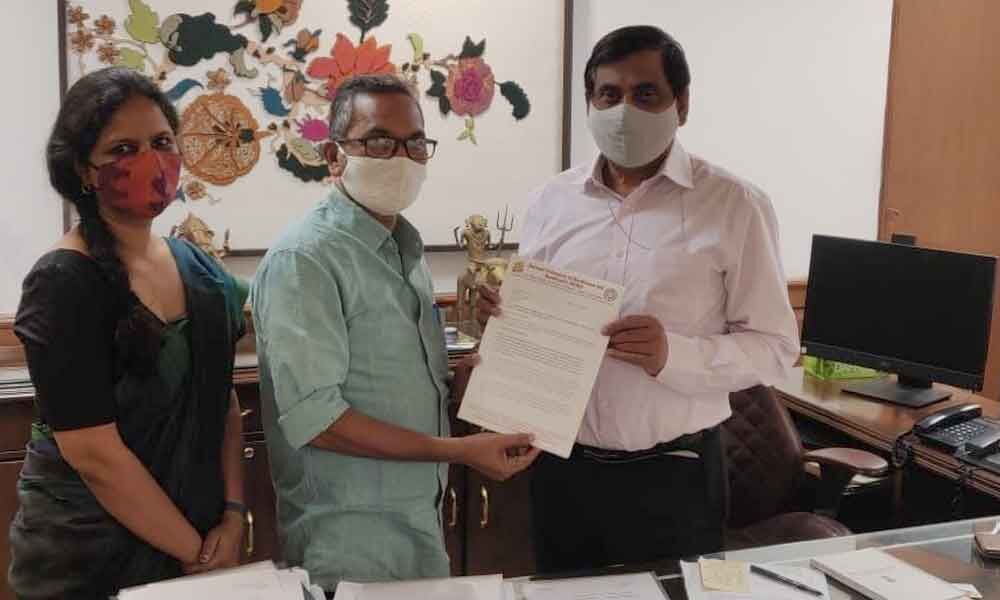Live
- CM to address public meeting in Kandukur today
- India needs to simultaneously grow hydrogen market and solar power
- Dissecting India’s employment scenario brings forth startling revelations
- Yerragondapalem: YSRCP manifesto has upset people, says Erixion Babu
- Hindi’s powerful voice falls silent
- Narasaraopet: ‘House sites will be sanctioned for pastors’
- I understand struggles faced by people: Waliullah
- AP LAWCET Application Deadline Extended to May 4; Exam on June 9
- BRS turns 23, vows to continue fight for people
- From boardroom battles to poll fields, moneybags have it easy
Just In
Protect handloom products from power loom units: NFHH


NFHH members Macherla Mohan Rao and Gunjan Jain submitting a memorandum to UP Singh, Secretary of Ministry of Textiles
NFHH members submits memorandum to UP Singh, the Secretary of Ministry of Textiles, Government of India in New Delhi
Ongole: The representatives of the National Federation of Handlooms and Handicrafts (NFHH) submitted a memorandum to UP Singh, the Secretary of Ministry of Textiles, Government of India in New Delhi and shared few suggestions on urgent issues faced by the handloom weavers across the country and requested the ministry to strengthen the handloom sector and consider them in framing New Textile Policy.
The NFHH members Macherla Mohan Rao, Gunjan Jain and Ankush Seth, in their representation to the Ministry of Textiles explained that the power loom industries are producing many handloom reserved items and selling them as handloom products in the market damaging the livelihood of genuine handloom weavers. They requested the government to amend section 8 and 9 of the Handloom Reservation Act 1985 penalising the power loom industries for violating the law. They advised the authorities to develop a tool/machine to distinguish between the handloom and power loom product in association with the IITs, RECs and other central universities. They also requested the government to exempt the yarns, dyes, chemicals and handlooms from the Goods and Services Tax to protect the handloom industry.
Also, the members asked the government to involve students from NIFT, NID and other design institutes as interns in the handloom sector and encourages them to introduce new designs as per the fashion trend. They discussed that the technology upgradation fund was misused recently by introducing pneumatic and power-operated tools like jacquard machines in the handlooms and requested the authorities to take the feedback of the stakeholders and take initiatives to develop future-oriented technologies without using electricity and other intrusive technologies, to help all sections of handloom weavers in the country. They asked the government to establish the Knowledge Centres of Handloom Process and Products to add knowledge and value along with protecting the intellectual property rights.
They advised the government to provide grants to establish small scale spinning units at village level for weavers to have access to yarns in small quantities and at low cost, see the NHDC depots and cooperative societies supply ready-to-weave yarn to the weavers, take up an action research programme for at least 3 years to supply Hank Yark produced by 4 or 5 NTC spinning mills to the weavers through NHDC. They demanded the government to recognise handloom workers by providing ID cards, implement a thrift cum savings scheme by deducting some of the earnings of the weavers and use it as a contribution to implement ESI, EPF and EPS for them. They also advised the government to implement every welfare scheme meant for the weavers to all handloom weavers and craft persons between 18 and 70 years. They asked the government to restore the Health Insurance Scheme by enhancing the limit to Rs 50,000 per year to meet the outpatient expenditure of weavers' family members, as the Rashtriya Swasthya Bima Yojana is not implemented in all States. They said that the government should implement Credit Guarantee Linked Consumption Loan to weavers and deduct EMIs from the wages, through cooperative societies. They asked the authorities to implement MNREGA for the handloom community in rural India for a minimum of 25 days, by providing a wage incentive of Rs 25 per metre at a maximum of 5 metres per day. They advised the government to constitute a working group of handloom weavers, practitioners and scholars, to have in-depth discussions with stakeholders to obtain clarity on complex problems faced by the handloom sector.

© 2024 Hyderabad Media House Limited/The Hans India. All rights reserved. Powered by hocalwire.com






